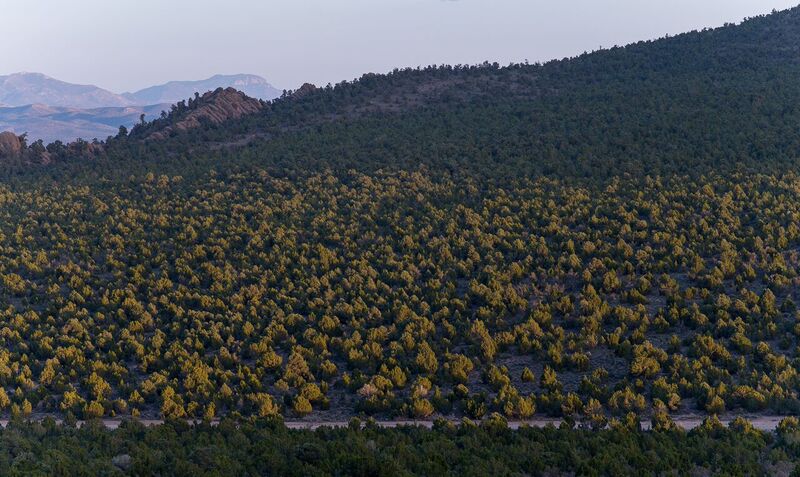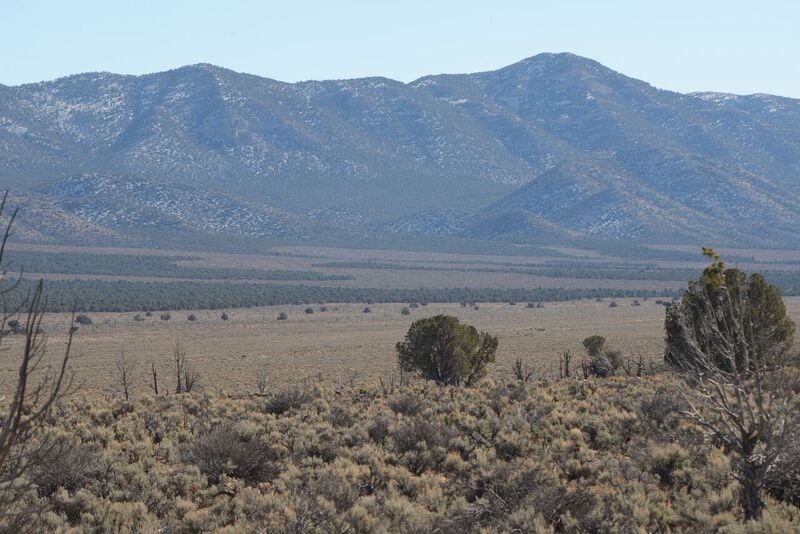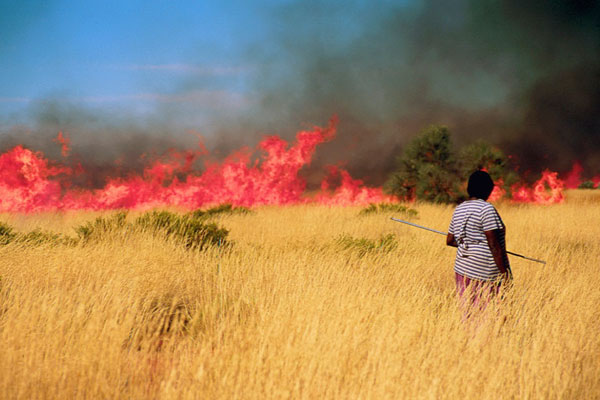Once I recovered from the shock I experienced witnessing the carnage produced by a Bureau of Land Management’s (BLM) so-called “pinyon-juniper treatment project” just south of Spruce Mountain in Nevada, all I wanted was the destruction to stop. In order to stop the destruction, we have to ask the question: “Why are they doing this?”
BLM’s justifications [are] moving targets … Once a justification is proved to be based on bad science and incomplete research, BLM throws up a new target.
To learn the answer, I embarked on a long, strange trip through BLM documents, books on pinyon pine trees, YouTube propaganda, and countless scientific articles. I found so many justifications, my head was spinning. On a phone call with staff from the Southern Utah Wilderness Alliance (SUWA), Field Attorney Neal Clark described BLM’s justifications as “moving targets.” Once a justification is proved to be based on bad science and incomplete research, BLM throws up a new target. Meanwhile, the destruction of pinyon-juniper forests intensifies.
The BLM, Carson City District, Sierra Front Field Office is proposing a vegetation treatment project in the Virginia Mountains area north of Reno and west of Pyramid Lake in Washoe County, Nevada. The Virginia Mountains Vegetation Treatment Project would destroy “approximately 30,387 acres” of pinyon-juniper forest.
The BLM’s online notice lists some of the most common excuses used for pinyon-juniper deforestation. Those excuses include: to “reduce the potential of large-scale high severity wild land fire,” “provide for public and firefighter safety and protection of property and infrastructure,” “maintain sagebrush habitat, riparian plant communities, wet meadows, and springs,” and “protect and enhance historic juniper woodland habitat.” In order to achieve these goals, the BLM’s online notice says the “proposed treatments include mechanical mastication, mechanical removal, hand cutting, chemical treatments, chaining, and seeding.”
BLM’s claims in their campaign against pinyon-juniper forests directly contradict the body of scientific literature.
Of course, the notice ends with the currently fashionable nod to protecting greater sage-grouse habitat and reads, “treatments would be designed to address threats to greater sage-grouse from invasive annual grasses, wildfires, and conifer expansion.”
When BLM claims that their proposed pinyon-juniper treatment projects will achieve the results like the ones listed in the Carson City District, Sierra Front Field Office’s notice, they are making claims that are not supported by scientific research. In fact, many of BLM’s claims in their campaign against pinyon-juniper forests directly contradict the body of scientific literature.
Since I began researching pinyon-juniper forests, writing this Pinyon-Juniper Forest series, and participating in a grass-roots campaign to demand a nationwide moratorium on pinyon-juniper deforestation, I have heard BLM’s claims replicated many times. It is time their erroneous assertions are put to rest. In this essay, I will address the common justifications BLM uses for destroying pinyon-juniper forests and show how BLM is lying.
***
The first reason BLM’s Carson City District, Sierra Front Field Office uses to support its proposal to clear-cut 30,387 acres of living forest is typical in the nationwide assault on pinyon-juniper forests. BLM claims their proposed project will “reduce the potential of large-scale high severity wild land fire.” According to BLM, this will “provide for public and firefighter safety and protection of property and infrastructure.”
BLM’s justification suggests that there is a serious potential for high severity, wild land fire in pinyon-juniper forests, but is that true?
William L. Baker and Douglas Shinneman wrote an article “Fire and Restoration of Piñon-Juniper Woodlands in the Western United States: A Review” (PDF) which is considered one of the leading reviews of fire incidence in pinyon-juniper forests. Baker and Shinneman argue that there simply is not enough scientific evidence for land managers to apply uniform fire and structural treatments like BLM’s proposed Virginia Mountains Treatment Project in pinyon-juniper forests.
[The BLM’s proposed] treatments have actually been found to increase pinyon-juniper forests’ potential for burning.
Not only are scientists cautioning BLM not to assume pinyon-juniper forests have a serious risk of large scale fire, mechanical treatments have actually been found to increase pinyon-juniper forests’ potential for burning. Allison Jones, Jim Catlin, and Emanuel Vazquez, working for the Wild Utah Project, wrote an essay titled “Mechanical Treatment of Piñon-Juniper and Sagebrush Systems in the Intermountain West: A Review of the Literature” (PDF). Their essay is a comprehensive review of the scientific literature surrounding pinyon-juniper forests and their review undermines many of the goals often given as the reasons for prescribed mechanical treatments of pinyon-juniper forests.
In regards to using pinyon-juniper mechanical treatment as a tool for reducing the potential of wild land fire, Jones et al. write, “There are… many studies that report when piñon-juniper is mechanically treated and if cheatgrass and/or other exotic annuals are present in the system before treatment, then cover of these species will increase post-treatment.” Cheatgrass, of course, is an invasive species that quickly outcompetes native grasses. The relevant problem with cheatgrass is that it is more flammable. When cheatgrass dominates rangelands, it speeds up the natural fire interval of those rangelands. In other words, cheatgrass makes the land it occupies more prone to wild fires.
Regardless of what BLM says, what they are actually doing is contributing to global climate change, a longer wildfire season at home, and hastening the destruction of the entire planet.
When BLM rips up pinyon-juniper forests in the interests of reducing the potential for wildfires, their destruction produces the opposite of their stated goal. Instead of providing for public and firefighter safety, BLM is actually making it easier for cheatgrass to choke out native species which in turn makes it more likely the Great Basin will burn. On the global scale, we know that deforestation speeds climate change. Trees sequester carbon and the prevalence of carbon dioxide in the atmosphere is a leading cause of climate change. Warming climates lead to longer and more intense wildfire seasons. Wildfires burn forests releasing more carbon dioxide into the atmosphere and the vicious cycle intensifies. Regardless of what BLM says, what they are actually doing is contributing to global climate change, a longer wildfire season at home, and hastening the destruction of the entire planet. “Public and firefighter safety”? Hardly.
The next justification BLM’s Carson City District, Sierra Front Field Office lists for why it must destroy pinyon-juniper forests is to “maintain sagebrush habitat, riparian plant communities, wet meadows, and springs.” Before I address this justification, remember that BLM plans to maintain different plant habitats through processes like chaining tens of thousands of acres of living forest. Chaining, you may recall, involves stretching an anchor chain from a US Navy battleship between two trawler tractors and dragging the chain across the forest floor ripping up everything the tractors’ path. Chaining, BLM claims, improves sagebrush habitat, riparian plant communities, wet meadows, and springs.
There are two mistaken beliefs underlying BLM’s stated goal to maintain sage brush habitat, riparian plant communities, wet meadows, and springs. The first idea is rooted in BLM dogma that insists that pinyon-juniper forests are “encroaching” into lands (including sagebrush habitat) they did not previously occupy. The second idea accuses pinyon pine and juniper trees of somehow using too much water and hypothesizes that cutting these trees will lead to increased water yield. Both of these arguments have been soundly defeated in scientific literature.
The pinyon-juniper encroachment theory is a product of settler colonialism’s historical amnesia. One of the products of the white supremacy brought to the Great Basin by European settlers is a selective memory that ignores guilt-inducing facts of ecological destruction wrought on the Great Basin by European mining activities.
When BLM claims pinyon-juniper forests are encroaching, the forests are actually recovering from the shock of European development.
Pinyon pine expert Ronald Lanner described the catastrophic destruction of pinyon-juniper forests in Nevada in his book “The Piñon-Pine: A Natural and Cultural History.” Lanner explains how pinyon and juniper wood was essential for fuel for smelting operations, lumber for buildings in boom towns, and as mine supports in mine-shaft construction. Lanner says western Nevada’s Comstock mines used 18 million board feet of pinyon-juniper timber annually while Eureka, Nevada burned 17,850 bushels of pinyon-juniper charcoal daily. Lanner explains that by 1870 – a mere 11 years after the European discovery of silver in Nevada – charcoal makers had denuded forests for a 50 miles around Eureka, NV.
When BLM claims pinyon-juniper forests are encroaching, the forests are actually recovering from the shock of European development. It wasn’t just mining, either. Lanner estimates that 3 million acres of pinyon-juniper forests were destroyed to make room for cattle between 1960 and 1972 in the Great Basin and Intermountain West. Jones et al. explain that “what we see today in many cases is piñon-juniper simply recolonizing places where they were dominant but then gained in the 1940s to 1970s.” They go on to state, “what is actually natural recolonization is often mistaken for encroachment.”
A classic accusation hurled at juniper trees in particular is that they consume more water through their roots compared to other plants where junipers live. Jones et al. cite 8 recent studies to state that this simply is not the case. Jones et. al also demonstrate that mechanical treatments of pinyon-juniper forests do not produce the effects BLM wants the treatments to: “There are many indications from the literature that mechanical piñon-juniper…treatment, especially if followed by mechanical drill seeding, can fail to meet the goals of ‘ecological restoration and watershed health and productivity.” The seedings enable grazing by large herds of cattle that also disturb the soil crusts and cause flammable cheatgrass to proliferate.
Why do these mechanical treatment projects fail to promote restoration? They fail to promote restoration because, as Jones et al. explain, mechanical treatments are extremely destructive to biological crusts. Additionally, Jones et al. point out how mechanical treatments like chaining lead to the greatest degree of soil disturbance. And, soil losses due to erosion following destructive activities like chaining can take 5,000 to 10,000 years to reform.
Next, we have BLM’s claim that their Virginia Mountains Vegetation Treatment Project will “protect and enhance historic juniper woodland habitat.” Again, even without the science, it is difficult to understand how dragging a giant chain across a forest floor to rip up pinyon pine and juniper trees by their roots can protect and enhance the very juniper trees being destroyed. As you might expect, the science reveals the lunacy in BLM’s stated goal.
In addition to the way mechanical treatments of pinyon-juniper forests destroy a natural community’s biologic crust and lead to practically irreversible soil loss, Jones et al, describe how mechanical drill seeding or mechanical clearing of dead pinyon-juniper trees after a fire “can lead to significantly increased wind erosion…” They also state that, “there are many examples in the literature of cases where mechanical clearing of piñon-juniper has led to increases in erosion by both air and water.” And finally, they remind us that “any kind of land treatment that clears the existing vegetation and disturbs the soil (so all mechanical treatments but also fire and chemical treatments) can result in increases in exotic annuals, especially cheat grass, when these species are present in the system before treatment.”
It is quite clear, then, treatment projects like the proposed Virginia Mountains Vegetation Treatment Project do not protect and enhance historic juniper woodland habitat. These projects destroy historic juniper woodland habitat and seriously degrade the ecosystems they are found in.
***
Protecting greater sage-grouse habitat has become the newest justification for pinyon-juniper deforestation and BLM explains that the Virginia Mountains Treatment Project “would be designed to address threats to greater sage-grouse from invasive annual grasses, wildfires, and conifer expansion.”
These lists of threats to greater sage-grouse suggest that if BLM was truly interested in protecting the birds, they would spend their energy combating oil and gas development, conversion of land for agricultural use, and climate change.
First, we should double-check precisely what are the threats to greater sage-grouse. The World Wildlife Fund, for example, takes a slightly different perspective than BLM saying, “Unfortunately, because of oil and gas development, conversion of land for agricultural use, climate change and human development, sage grouse only inhabit half their historic range.” A similar website run by Defenders of Wildlife echoes WWF, “Remaining sagebrush habitat is fragmented and degraded by oil and gas drilling, livestock grazing, mining, unnatural fire, invasive weeds, off-road vehicles, roads, fences, pipelines and utility corridors.”
These lists of threats to greater sage-grouse suggest that if BLM was truly interested in protecting the birds, they would spend their energy combating oil and gas development, conversion of land for agricultural use, and climate change. I will play BLM’s game, though, to discover if mechanical treatments really will produce the results BLM thinks they will.
They will not, of course. Jones et al. made it clear that mechanical treatments of pinyon-juniper forests pave the way for invasive annual grasses to dominate treated areas. Invasive annual grasses choke the ground surface with continuous fuel, and burn more easily than clumped native bunchgrasses. And, as I wrote earlier, “mechanical treatments” are codespeak for deforestation. Deforestation leads to accelerated climate change which leads to more wildfires which kill greater sage-grouse.
I have already cited Lanner and Jones et al. (who cite many, many more) to explain that “conifer expansion” in most places is not really happening. This time, I want to address this argument from a psychological level. Notice how BLM is blaming conifer expansion for greater sage-grouse habitat loss while many other organizations are blaming oil and gas development, agricultural conversion, and mining. These other organizations, in other words, are blaming human expansion for greater sage-grouse habitat loss. When BLM’s rhetoric is viewed in this way, it becomes possible to analyze BLM’s words as a psychological distraction away from the role of humans in the destruction of the Great Basin. It is easier to blame trees than it is to blame humans for the deterioration of the Great Basin. Maybe this explains why so many readily accept BLM’s bogus arguments?
***
Learning that BLM is mistaken or spreading downright lies about what they’re doing to pinyon-juniper forests, the question, again, becomes, “Why?”
Why are they lying? How have they convinced themselves this is acceptable? Are they so beholden to ranching interests that their rationality has been destroyed by cattle money? Do they truly think they are doing what is best for the lands they “manage?” Or, with the amount of destruction they are wreaking on the Great Basin, do they hate pinyon-juniper forests?
I think there must be good-hearted people working for BLM who truly do care for the Great Basin. I wonder how they could have been misled in this way. I recall an article I recently read by Robert Jay Lifton, the brilliant psychologist who asked these very same questions of those involved in the rise of Nazism in his book “The Nazi Doctors.” Lifton’s article appeared in the New York Times and was called “The Climate Swerve” about the world’s deepening awareness of climate change.
Whether [the BLM staff] believe their false claims to virtue or not, is irrelevant for the thousands of acres of beautiful, ancient pinyon-juniper forests set to be destroyed by BLM. What matters is that we stop them.
In the article, Lifton explains, “Over the course of my work I have come to the realization that it is very difficult to endanger or kill large numbers of people except with a claim to virtue.” I would extend his realization to the natural world and explain that BLM’s justifications stand as their claims to virtue clearing their conscience before they murder millions of trees and the beings who live in them. The only way BLM can cut 30,387 acres of pinyon-juniper forests is to claim they are “protecting the public and firefighters” or “enhancing historic juniper woodland habitat” or addressing “threats to greater sage-grouse” so they do not have to face the truth of their violence.
Whether they believe their false claims to virtue or not, is irrelevant for the thousands of acres of beautiful, ancient pinyon-juniper forests set to be destroyed by BLM. What matters is that we stop them.




